Battle of Tsushima
The Battle of Tsushima (Japanese:対馬沖海戦, Tsushimaoki-Kaisen, Russian: Цусимское сражение, Tsusimskoye srazheniye), also known as the Battle of Tsushima Strait and the Naval Battle of Sea of Japan (Japanese: 日本海海戦, Nihonkai-Kaisen) in Japan, was a major naval battle fought between Russia and Japan during the Russo-Japanese War. It was naval history's first, and so far the last, decisive sea battle fought by modern steel battleship fleets[3][4] and the first naval battle in which wireless telegraphy (radio) played a critically important role. It has been characterized as the "dying echo of the old era – for the last time in the history of naval warfare, ships of the line of a beaten fleet surrendered on the high seas".[5]
| Battle of Tsushima | |||||||
|---|---|---|---|---|---|---|---|
| Part of the Russo-Japanese War | |||||||
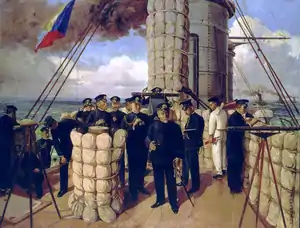 Admiral Tōgō on the "Compass Deck" above the bridge of Mikasa, at the beginning of the Battle of Tsushima in 1905. The signal flag being hoisted represents the letter Z, which was a special instruction to the Fleet.[lower-alpha 1] | |||||||
| |||||||
| Belligerents | |||||||
|
|
| ||||||
| Commanders and leaders | |||||||
|
|
| ||||||
| Strength | |||||||
|
5 battleships 29 cruisers 3 gunboats 21 destroyers 45 torpedo boats 22 auxiliary vessels |
8 battleships 3 coastal battleships 9 cruisers 9 destroyers 9 auxiliary vessels | ||||||
| Casualties and losses | |||||||
|
117 dead 583 injured 3 torpedo boats sunk (255 tons sunk) |
5,045 dead 803 injured 6,016 captured 6 battleships sunk 1 coastal battleship sunk 14 other ships sunk 2 battleships captured 2 coastal battleships captured 1 destroyer captured 6 ships disarmed (143,232 tons sunk) | ||||||
It was fought on 27–28 May 1905 (14–15 May in the Julian calendar then in use in Russia) in the Tsushima Strait located between Korea and southern Japan. In this battle the Japanese fleet under Admiral Tōgō Heihachirō destroyed the Russian fleet, under Admiral Zinovy Rozhestvensky, which had traveled over 18,000 nautical miles (33,000 km) to reach the Far East. In London in 1906, Sir George Sydenham Clarke wrote, "The battle of Tsu-shima is by far the greatest and the most important naval event since Trafalgar";[6] decades later, historian Edmund Morris agreed with this judgment.[7] The destruction of the fleet caused a bitter reaction from the Russian public, which induced a peace treaty in September 1905 without any further battles. Conversely, in Japan it was hailed as one of the greatest naval victories in Japanese history, and Admiral Tōgō was revered as a national hero.[lower-alpha 2] The battleship Mikasa, from which Tōgō commanded the battle, has been preserved as a museum ship in Yokosuka Harbour.
Prior to the Russo-Japanese War, countries constructed their battleships with mixed batteries of mainly 6-inch (152 mm), 8-inch (203 mm), 10-inch (254 mm) and 12-inch (305 mm) guns, with the intent that these battleships fight on the battle line in a close-quarter, decisive fleet action. The Battle of Tsushima conclusively demonstrated that battleship speed and big guns[8] with longer ranges were more advantageous in naval battles than mixed batteries of different sizes.[9]
Background
Conflict in the Far East
On 8 February 1904, destroyers of the Imperial Japanese Navy launched a surprise attack on the Russian Far East Fleet anchored in Port Arthur; three ships – two battleships and a cruiser – were damaged in the attack. The Russo-Japanese war had thus begun. Japan's first objective was to secure its lines of communication and supply to the Asian mainland, enabling it to conduct a ground war in Manchuria. To achieve this, it was necessary to neutralize Russian naval power in the Far East. At first, the Russian naval forces remained inactive and did not engage the Japanese, who staged unopposed landings in Korea. The Russians were revitalised by the arrival of Admiral Stepan Makarov and were able to achieve some degree of success against the Japanese, but on 13 April Makarov's flagship, the battleship Petropavlovsk, struck a mine and sank; Makarov was among the dead.[10] His successors failed to challenge the Japanese Navy, and the Russians were effectively bottled up in their base at Port Arthur.
By May, the Japanese had landed forces on the Liaodong Peninsula and in August began the siege of the naval station. On 9 August, Admiral Wilgelm Vitgeft, commander of the 1st Pacific Squadron, was ordered to sortie his fleet to Vladivostok,[11] link up with the Squadron stationed there, and then engage the Imperial Japanese Navy (IJN) in a decisive battle.[12] Both squadrons of the Russian Pacific Fleet would ultimately become dispersed during the battles of the Yellow Sea, where Admiral Vitgeft was killed by a salvo strike from the Japanese battleship Asahi, on 10 August; and the Ulsan on 14 August 1904. What remained of Russian Pacific naval power would eventually be sunk in Port Arthur.[13]
Departure
With the inactivity of the First Pacific Squadron after the death of Admiral Makarov and the tightening of the Japanese noose around Port Arthur, the Russians considered sending part of their Baltic Fleet to the Far East. The plan was to relieve Port Arthur by sea, link up with the First Pacific Squadron, overwhelm the Imperial Japanese Navy, and then delay the Japanese advance into Manchuria until Russian reinforcements could arrive via the Trans-Siberian railroad and overwhelm the Japanese land forces in Manchuria. As the situation in the Far East deteriorated, the Tsar (encouraged by his cousin Kaiser Wilhelm II),[14] agreed to the formation of the Second Pacific Squadron.[15] This would consist of five divisions of the Baltic Fleet, including 11 of its 13 battleships. The squadron departed the Baltic ports of Reval (Tallinn) and Libau (Liepāja) on 15–16 October 1904 (Rozhestvensky and von Fölkersahm fleets), and the Black Sea port of Odessa on 3 November 1904 (armored cruisers Oleg and Izumrud, auxiliary cruisers Rion and Dnieper under the command of Captain Leonid Dobrotvorsky[16]), numbering 42 ships and auxiliaries.[lower-alpha 3][17]
Dogger Bank
The Rozhestvensky and von Fölkersahm fleets sailed through the Baltic into the North Sea. The Russians had heard fictitious reports of Japanese torpedo boats operating in the area and were on high alert. In the Dogger Bank incident, the Russian fleet mistook a group of British fishing trawlers operating near the Dogger Bank at night for hostile Japanese ships. The fleet fired upon the small civilian vessels, killing several British fishermen; one trawler was sunk while another six were damaged.[15] In confusion, the Russians even fired upon two of their own vessels, killing some of their own men. The firing continued for twenty minutes before Rozhestvensky ordered firing to cease; greater loss of life was avoided only because the Russian gunnery was highly inaccurate.[18] The British were outraged by the incident and incredulous that the Russians could mistake a group of fishing trawlers for Japanese warships, thousands of kilometres from the nearest Japanese port. Britain almost entered the war in support of Japan, with whom it had a mutual defense agreement (but was neutral in the war, as their treaty contained a specific exemption for Japanese actions in China and Korea). The Royal Navy sortied and shadowed the Russian fleet while a diplomatic agreement was reached.[15] France, which had hoped to eventually bring the British and Russians together in an anti-German bloc, intervened diplomatically to restrain Britain from declaring war.[15] The Russians were forced to accept responsibility for the incident, compensate the fishermen, and disembark officers who were suspected of misconduct to give evidence to an enquiry.[19][20]
Routes
_NT.PNG.webp)
Concerns that the draught of the newer battleships, which had proven to be considerably greater than designed,[22] would prevent their passage through the Suez Canal caused the fleet to separate after leaving Tangiers on 3 November 1904. The newer battleships and a few cruisers proceeded around the Cape of Good Hope under command of Admiral Rozhestvensky while the older battleships and lighter cruisers made their way through the Suez Canal under the command of Admiral von Fölkersahm. They planned to rendezvous in Madagascar, and both sections of the fleet successfully completed this part of the journey.[23] The longer journey around Africa took a toll on the Russian crews under Rozhestvensky, "who had never experienced such a different climate or such a long time at sea" as "conditions on the ships deteriorated, and disease and respiratory issues killed a number of sailors".[20] The voyage took half a year in rough seas, with difficulty obtaining coal for refueling – as the warships could not legally enter the ports of neutral nations – and the morale of the crews plummeted. The Russians needed 500,000 short tons (450,000 t) of coal and 30 to 40 re-coaling sessions to reach French Indochina (now Vietnam), and coal was provided by 60 colliers from the Hamburg-Amerika Line. By April and May 1905 the reunited fleet had anchored at Cam Ranh Bay in French Indochina.[lower-alpha 4][17][24][25]
The Russians had been ordered to break the blockade of Port Arthur, but the battleships in the port were sunk by the Japanese army land artillery, and the heavily fortified city/port had already fallen on 2 January just after the Second Pacific Squadron arrived in Nossi Be, Madagascar, before the arrival of the Fölkersahm detachment. The objective was therefore shifted to linking up with the remaining Russian ships stationed in the port of Vladivostok, before bringing the Japanese fleet to battle.[26]
Prelude
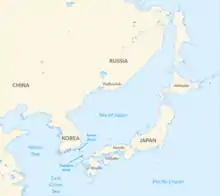
The Russians had three possible routes to enter the Sea of Japan and reach Vladivostok: the longer were the La Pérouse Strait and Tsugaru Strait, on either side of Hokaido. Admiral Rozhestvensky did not reveal his choice even to his subordinates until 25 May, when it became apparent he chose Tsushima by ordering the fleet to head North East after detaching transports Yaroslavl, Vladimir, Kuronia, Voronezh, Livonia and Meteor as well as auxiliary cruisers Rion and Dniepr with the instruction to go to the near-by neutral port of Shanghai.[27]: Book 1, Part 4 The Tsushima Strait is the body of water eastward of the Tsushima Island group, located midway between the Japanese island of Kyushu and the Korean Peninsula, the shortest and most direct route from Indochina. The other routes would have required the fleet to sail east around Japan.[lower-alpha 5] The Japanese Combined Fleet and the Russian Second and Third Pacific Squadrons, sent from the Baltic Sea now numbering 38, would fight in the straits between Korea and Japan near the Tsushima Islands.[27]: Book 1, Part 4
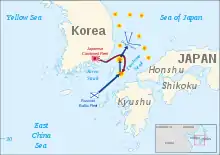
Because of the 18,000-mile (29,000 km) journey, the Russian fleet was in relatively poor condition for battle. Apart from the four newest Borodino-class battleships, Admiral Nebogatov's 3rd Division[28] consisted of older and poorly maintained warships. Overall neither side had a significant maneuverability advantage.[29] The long voyage, combined with a lack of opportunity for maintenance, meant the Russian ships were heavily fouled, significantly reducing their speed.[30] The Japanese ships could sustain 15 knots (28 km/h), but the Russian fleet could reach just 14 knots (26 km/h), and then only in short bursts.[29]
Additionally, there were significant deficiencies in the Russian naval fleet's equipment and training. Russian naval tests with their torpedoes exposed major technological failings.[lower-alpha 6] Tōgō's greatest advantage was that of experience, having all of the five fleet commanders in either navy with combat experience aboard modern warships on his side.[lower-alpha 7] The others were all Russian admirals whom he had defeated, including Oskar Starck, who had been relieved of his command following his humiliating defeat in the Battle of Port Arthur; Admiral Stepan Makarov, killed by a mine off Port Arthur; and Wilgelm Vitgeft, who had been killed in the Battle of the Yellow Sea.[31]
Battle
First contact
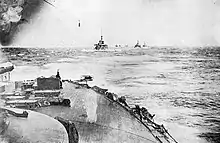
Because the Russians desired to slip undetected into Vladivostok, as they approached Japanese waters they steered outside regular shipping channels to reduce the chance of detection. On the night of 26 May 1905 the Russian fleet approached the Tsushima Strait.
In the night, thick fog blanketed the straits, giving the Russians an advantage. At 02:45 on 27 May Japan Standard Time (JST), the Japanese auxiliary cruiser Shinano Maru observed three lights on what appeared to be a vessel on the distant horizon and closed to investigate. These lights were from the Russian hospital ship Orel, which, in compliance with the rules of war, had continued to burn them.[32] At 04:30, Shinano Maru approached the vessel, noting that she carried no guns and appeared to be an auxiliary. The Orel mistook the Shinano Maru for another Russian vessel and did not attempt to notify the fleet. Instead, she signaled to inform the Japanese ship that there were other Russian vessels nearby. The Shinano Maru then sighted the shapes of ten other Russian ships in the mist. The Russian fleet had been discovered, and any chance of reaching Vladivostok undetected had disappeared.
Wireless telegraphy played an important role from the start. At 04:55, Captain Narukawa of the Shinano Maru sent a message to Admiral Tōgō in Masampo that the "Enemy is in square 203". By 05:00, intercepted radio signals informed the Russians that they had been discovered and that Japanese scouting cruisers were shadowing them. Admiral Tōgō received his message at 05:05, and immediately began to prepare his battle fleet for a sortie.
Beginning of the battle
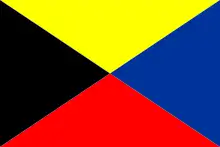
At 06:34, before departing with the Combined Fleet, Admiral Tōgō wired a confident message to the navy minister in Tokyo:
In response to the warning that enemy ships have been sighted, the Combined Fleet will immediately commence action and attempt to attack and destroy them. Weather today fine but high waves.[33]
The final sentence of this telegram has become famous in Japanese military history, and has been quoted by former Japanese Prime Minister Shinzō Abe.[34]
At the same time the entire Japanese fleet put to sea, with Tōgō in his flagship Mikasa leading over 40 vessels to meet the Russians. Meanwhile, the shadowing Japanese scouting vessels sent wireless reports every few minutes as to the formation and course of the Russian fleet. There was mist which reduced visibility and the weather was poor. Wireless gave the Japanese an advantage; in his report on the battle, Admiral Tōgō noted the following:
Though a heavy fog covered the sea, making it impossible to observe anything at a distance of over five miles, [through wireless messaging] all the conditions of the enemy were as clear to us, who were 30 or 40 miles distant, as though they had been under our very eyes.[35]
At 13:40, both fleets sighted each other and prepared to engage. At around 13:55, Tōgō ordered the hoisting of the Z flag, issuing a predetermined announcement to the entire fleet:
The Empire's fate depends on the result of this battle, let every man do his utmost duty.[36]
By 14:45, Tōgō had 'crossed the Russian T'[37] enabling him to fire broadsides, while the Russians could reply only with their forward turrets.[38][39]
Daylight action
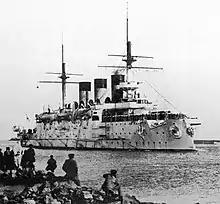
The Russians sailed from south southwest to north northeast; "continuing to a point of intersection which allowed only their bow guns to bear; enabling him [Tōgō] to throw most of the Russian batteries successively out of bearing."[40] The Japanese fleet steamed from northeast to west, then Tōgō ordered the fleet to turn in sequence, which enabled his ships to take the same course as the Russians, although risking each battleship consecutively. Although Tōgō's U-turn was successful, Russian gunnery had proven surprisingly good and the flagship Mikasa was hit 15 times in five minutes. Before the end of the engagement she was struck 15 more times by large caliber shells.[41] Rozhestvensky had only two alternatives, "a charge direct, in line abreast", or to commence "a formal pitched battle."[40] He chose the latter, and at 14:08, the Japanese flagship Mikasa was hit at about 7,000 metres, with the Japanese replying at 6,400 meters. Superior Japanese gunnery then took its toll,[42] with most of the Russian battleships being crippled.
Commander Vladimir Semenoff, a Russian staff officer aboard the flagship Knyaz Suvorov, said "It seemed impossible even to count the number of projectiles striking us. Shells seemed to be pouring upon us incessantly one after another.[43] The steel plates and superstructure on the upper decks were torn to pieces, and the splinters caused many casualties. Iron ladders were crumpled up into rings, guns were literally hurled from their mountings. In addition to this, there was the unusually high temperature and liquid flame of the explosion, which seemed to spread over everything. I actually watched a steel plate catch fire from a burst."[44]
Ninety minutes into the battle, the first warship to be sunk was the Russian battleship Oslyabya from Rozhestvensky's 2nd Battleship division. This was the first time a modern armoured warship had been sunk by gunfire alone.[45]
A direct hit on the Russian battleship Borodino's magazines by the Japanese battleship Fuji caused her to explode, which sent smoke thousands of metres into the air and trapped all of her crew on board as she sank.[44] Rozhestvensky was knocked out of action by a shell fragment that struck his skull. In the evening, Rear Admiral Nikolai Nebogatov took over command of the Russian fleet. The Russians lost the battleships Knyaz Suvorov, Oslyabya, Imperator Aleksandr III and Borodino. The Japanese ships suffered only light damage.
Night attacks
At night, around 20:00, 21 destroyers and 45 Japanese torpedo boats[lower-alpha 9] were thrown against the Russians.[lower-alpha 10] The destroyers attacked from the vanguard while the torpedo boats attacked from the east and south of the Russian fleet. The Japanese were aggressive, continuing their attacks for three hours without a break, as a result during the night, there were a number of collisions between the small craft and Russian warships. The Russians were now dispersed in small groups trying to break northwards. By 23:00, it appeared that the Russians had vanished, but they revealed their positions to their pursuers by switching on their searchlights – ironically, the searchlights had been turned on to spot the attackers. The old battleship Navarin struck a chained floating mine laid in front, and was forced to stop in order not to push the chain forward, inviting other floating mines on the chain in on herself. She was consequently torpedoed four times and sunk. Out of a crew of 622, only three survived, one to be rescued by the Japanese and the other two by a British merchant ship.[46]
The battleship Sissoi Veliky was badly damaged by a torpedo in the stern, and was scuttled the next day. Two old armoured cruisers – Admiral Nakhimov and Vladimir Monomakh – were badly damaged, the former by a torpedo hit to the bow, the latter by colliding with a Japanese destroyer. They were both scuttled by their crews the next morning off Tsushima Island, where they headed while taking on water.[47] The night attacks placed a great strain on the Russians, as they lost two battleships and two armoured cruisers, while the Japanese lost only three torpedo boats.[48]
XGE signal and Russian surrender
At 05:23 on 28 May, what remained of the Russian fleet was sighted heading northeast. Tōgō's battleships proceeded to surround Nebogatov's remaining squadron south of the island of Takeshima and commenced main battery fire at 12,000 meters.[49] The Russian cruiser Izumrud then turned South and attempted to flee.[1]: p.116 Realising that his guns were outranged by at least one thousand metres [lower-alpha 12] and the Japanese battleships had proven on the day before to be faster than his own so that he could not close the distance, Nebogatov ordered the six ships remaining under his command to surrender.[lower-alpha 13] XGE, an international signal of surrender, was hoisted; however, the Japanese navy continued to fire as they did not have "surrender" in their code books and had to hastily find one that did.[50] Still under heavy fire, Nebogatov then ordered a white table cloth sent up the masthead, but Tōgō, having had a Chinese warship escape him while flying that flag during the 1894 war, did not trust them.
Moreover, his lieutenants found the codebook that included XGE signal and reported that stopping of engines is a requirement for the signal to mean 'surrender' and all the Russian ships were still moving, so he continued firing while response flag signal "STOP" hoisted.[1]: pp.119-120 Nebogatov then ordered St.Andrew's Cross lowered and the Japanese national flag raised on the gaff and all engines stopped.[51] Seeing the Japanese flag raised as the ensign, Tōgō gave the cease fire and accepted Nebogatov's surrender. Nebogatov surrendered knowing that he could be shot for doing so.[44] He said to his men:
You are young, and it is you who will one day retrieve the honour and glory of the Russian Navy. The lives of the two thousand four hundred men in these ships are more important than mine.[44]
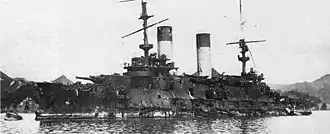
As an example of the level of damage inflicted on a Russian battleship, Oryol was hit by five 12-inch, nine 8-inch, 39 six-inch and 21 smaller or unidentified shells.[lower-alpha 15] This damage caused her to list, and the engine ceased to operate when she was being taken by the Japanese navy to First Battle Division home port of Sasebo in Nagasaki after Tōgō accepted the surrender. Battleship Asahi had to tow Oryol, and their destination was changed to the closer Maizuru Naval Arsenal to avoid losing the prize of war.[1]: pp.122, 136–141
The wounded Admiral Rozhestvensky went to the Imperial Japanese Naval Hospital in Sasebo to recover from a head injury caused by shrapnel; there, the victorious Admiral Tōgō visited him personally in plain clothes, comforting him with kind words: "Defeat is a common fate of a soldier. There is nothing to be ashamed of in it. The great point is whether we have performed our duty".[52]
Nebogatov and Rozhestvensky were placed on trial on return to Russia. Rozhestvensky claimed full responsibility for the fiasco and was sentenced to death, but as he had been wounded and unconscious during the last part of the battle, the Tsar commuted his death sentence. Nebogatov, who had surrendered the fleet, was imprisoned for several years and eventually pardoned by the Tsar.
Until the evening of 28 May, isolated Russian ships were pursued by the Japanese until almost all were destroyed or captured. Three Russian warships reached Vladivostok. The cruiser Izumrud, which escaped from the Japanese despite being present at Nebogatov's surrender, was destroyed by her crew after running aground on the Siberian coast.[53]
Contributing factors
Commander and crew experience
Admiral Rozhestvensky faced a more combat-experienced battleship admiral in Tōgō Heihachirō. Admiral Tōgō had already killed two Russian admirals: Stepan Makarov outside of Port Arthur in the battleship Petropavlovsk in April 1904, then Wilgelm Vitgeft in his battleship Tsesarevich in August of the same year. Before those two deaths, Tōgō had chased Admiral Oskar Starck, also flying his flag in the Petropavlovsk, off the battlefield. Admiral Tōgō and his men had two battleship fleet action experiences, which amounted to over four hours of combat experience in battleship-to-battleship combat at Port Arthur and the Yellow Sea.[54] The Japanese fleets had practiced gunnery extensively since the beginning of the war, using sub-calibre practice guns[lower-alpha 16] mounted in their larger guns.[lower-alpha 17][lower-alpha 18]
In contrast, Russian battleship Borodino underwent sea trials from 23 August to 13 September 1904[51] as a brand new ship upon her completion,[56] and the new crew did not have much time for training before she set sail for the Pacific on 15 October 1904. Borodino's sister ship, Knyaz Suvorov started trials on 9 August, Oryol started trials the latest on 10 September 1904, leaving Imperator Aleksandr III (the trials finished in October 1903) as the only Borodino-class ship actually ready for deployment.[51][lower-alpha 19] As the Imperial Russian Navy planned on building 10 Borodino-class battleships (5 were ultimately built) with the requirement for thousands of additional crewmen, the basic training, quality and experience of the crew and cadets were far lower[57] than those on board the battleships in the seasoned Pacific Fleet.[58]
%252C_from-_A_pictorial_description_of_Broadway_from_The_Mail_and_Express_Advertisement_14_(cropped).jpg.webp)
The Imperial Russian Admiralty Council (Адмиралтейств-совет) and the rest of the Admiralty were quite aware of this disadvantage, and opposed the October dispatch plan for the following reasons:
1. The Japanese navy has completed the battle preparations with all the crew having some combat experiences.
2. The long voyage is mostly through extreme tropical weather, so meaningful training is practically impossible on the way.
3. Therefore, the newly created Second Pacific Fleet should conduct training in the Baltic until the next spring while waiting for the rigging of another battleship, Slava,[lower-alpha 20] and the purchase of Chilean and Argentine warships[lower-alpha 21].[51]
However, at the council in the imperial presence on 23 August 1904 held at the Peterhof Grand Palace, this opinion was overruled by Admiral Rozhestvensky (Commander in Chief of the Fleet), Navy Minister Avellan, and Tsar Nicholas II; for it was deemed impossible to re-arrange the massive coaling for the long voyage if the navy broke the contract that was already signed with Hamburg-American Steamship Line of Germany.[51]
Salvo firing director system
Up to the Battle of the Yellow Sea on 10 August 1904, naval guns were controlled locally by a gunnery officer assigned to that gun or a turret. He specified the elevation and deflection figures, gave the firing order while keeping his eyes on the artificial horizon gauge indicating the rolling and pitching angles of the ship, received the fall of shot observation report from the spotter on the mast, calculated the new elevation and deflection to 'walk' the shots in on the target for the next round, without much means to discern or measure the movements of his own ship and the target. He typically had a view on the horizon, but with the new 12" gun's range extended to over 8 miles (13 km), his vantage point was lower than desired.
In the months before the battle, the Chief Gunnery Officer of Asahi, Commander 3rd rank Katō Hiroharu, aided by a Royal Navy advisor who introduced him to the use of the early mechanical computer Dumaresq in fire control, introduced a system for centrally issuing the gun-laying and salvo-firing orders. Using a central system allowed the spotter to identify a salvo of distant shell splashes much more effectively than trying to identify a single splash among the many in the confusion of a fleet-to-fleet combat.[59] Further, the spotter needed to keep track of just one firing at a time as opposed to multiple shots on multiple stopwatches, in addition to having to report to just one officer on the bridge. The 'director' officer on the bridge had the advantage of having a higher vantage point than in the gun turrets, in addition to being steps away from the ship commander giving orders to change the course and the speed in response to the incoming reports on target movements.
This fire control director system was introduced to other ships in the fleet with Katō being promoted to the Chief Gunnery Officer of the fleet flagship Mikasa in March 1905.[60] The training and practice on this system were carried out in the months waiting for the arrival of the Baltic Fleet[59][lower-alpha 18][lower-alpha 17] while its progress was reported by the British intelligence from their naval stations at Gibraltar, Malta, Aden(Yemen), Cape of Good Hope, Trincomalee(Ceylon), Singapore and Hong Kong, among other locations.[61]
As a result, Japanese fire was more accurate in the far range (3–8 miles (4.8–12.9 km)), on top of the advantage they held in the shorter distances using the latest 1903 issue Barr and Stroud FA3 coincidence rangefinders of baselength 5ft,[lower-alpha 22] which had a range of 6,000 yards (5.5 km), while the Russian battleships were equipped with Liuzhol stadiametric rangefinders from the 1880s (except battleships Oslyabya and Navarin, which had the Barr and Stroud 1895 issue FA2 of baselength 4.5ft retrofitted), which only had a range of about 4,000 metres (4.0 km).[62]
Wireless telegraphy
The wireless telegraph (radio) had been invented during the last half of the 1890s, and by the turn of the century nearly all major navies were adopting this improved communications technology. Tsushima was "the first major sea battle in which wireless played any role whatsoever".[63][64]
Lieutenant Akiyama Saneyuki (who was the key staff to Admiral Tōgō in formulating plans and directives before and during the battle as a Commander, who also went onboard Nikolai I to accept Admiral Nebogatov's surrender as Tōgō's representative) had been sent to the United States as a naval attaché in 1897. He witnessed firsthand the capabilities of radio telegraphy and sent a memo to the Navy Ministry urging that they push ahead as rapidly as possible to acquire the new technology.[64] The ministry became heavily interested in the technology; however it found the cost of the Marconi wireless system, which was then operating with the Royal Navy, to be exceedingly expensive. The Japanese therefore decided to create their own radio sets by setting up a radio research committee under Professor Kimura Shunkichi,[lower-alpha 23] which eventually produced an acceptable system. In 1901, having attained radio transmissions of up to 70 miles (110 km), the navy formally adopted radio telegraphy. Two years later, a laboratory, a factory, and a radio communication school were set up at Yokosuka Naval Arsenal to produce the Type 36 (1903) radios, and these were quickly installed on every major warship in the Combined Fleet by the time the war started.[64]
Alexander Stepanovich Popov of the Naval Warfare Institute had built and demonstrated a wireless telegraphy set in 1900. However, technology improvement and production in the Russian empire lagged those of Germany, and "System Slaby-Arco",[lower-alpha 24][65] originally made by D.R.P. Allgemeine Elektricitäts-Gesellschaft (AEG) and then produced in volume by its successor radio maker Telefunken in Germany (by 1904, this system was in wide use by Kaiserliche Marine) was adopted by the Imperial Russian Navy. Although both sides had early wireless telegraphy, the Russians were using German sets tuned and maintained by German technicians half-way into the voyage,[27] while the Japanese had the advantage of using their own equipment maintained and operated by their own navy specialists trained at the Yokosuka school.
British support
The United Kingdom assisted Japan by building battleships for the IJN.[66] The UK also assisted Japan in intelligence, finance, technology, training and other aspects of the war against Russia. At the time, Britain owned and controlled more harbor facilities around the world – specifically shipyards and coaling stations – than Russia and its allies (France, and to some extent Germany) combined. The UK also obstructed, where possible, Russian attempts to purchase ships and coal.[61]
At the end of the Argentine-Chilean naval arms race in 1903, two Chilean-ordered and British-built battleships (then called Constitución and Libertad) and two Argentinean-ordered, Italian-built cruisers (then called Bernardino Rivadavia and Mariano Moreno) were offered to Russia and the purchase was about to be finalized.[67] Britain stepped in as the mediator of Pacts of May that ended the race, bought the Chilean battleships (which became HMS Swiftsure and HMS Triumph), and brokered the sale of Argentinean cruisers to Japan. This support not only limited the growth of the Imperial Russian Navy, but also helped IJN in obtaining the latest Italian-built cruisers (IJN Kasuga and Nisshin) that played key roles in this battle.
Also, this support created a major logistics problem for around the world deployment of the Baltic Fleet to the Pacific in procuring coal and supplies on the way.[68][69] At Nosy Be in Madagascar and at Camranh Bay, French Indochina, the fleet was forced to be anchored for about two months each, seriously degrading morale of the crew. By the time it reached the Sea of Japan after crossing the warm waters of the equator twice, the hulls of all the ships in the fleet were heavily fouled in addition to carrying the extra coal otherwise not required on deck.[70][lower-alpha 4]
The Japanese ships, on the other hand, were well maintained in the ample time given by the intelligence. For example, battleship Asahi was under repair from November 1904 to April 1905 at Sasebo for two 12" guns lost and serious damage to the hull from striking a mine. They were divided into battle divisions of as much uniform speed and gun range so that a fleet would not suffer a bottleneck in speed, and the range of guns would not render some ships useless within a group in an extended range combat.[71][lower-alpha 8]
High explosive and cordite
The Japanese used mostly high-explosive shells filled with Shimose powder, which was a pure picric acid (as opposed to the French Melinite or the British Lyddite, which were picric acid mixed with collodion (French) or with dinitrobenzene and vaseline (British) for stability).[72] Engineer Shimose Masachika (1860-1911) solved the instability problem of picric acid on contact with iron and other heavy metals by coating the inside of a shell with unpigmented Japanese lacquer and further sealing with wax.[73] Because it was undiluted, Shimose powder had a stronger power in terms of detonation velocity and temperature than other high explosives at the time.[72] These shells had a sensitive Ijuin fuse[74] (named after its inventor, Ijuin Goro) at the base as opposed to the tip of a shell that armed itself when the shell was spun by the rifling. These fuses were designed to explode on contact and wreck the upper structures of ships.[75] The Japanese Navy imported cordite from Great Britain as the smokeless propellant for these Shimose shells,[72] so that the smoke off the muzzle would not impede the visibility for the spotters.
In the early 1890s, Vice Admiral Stepan O. Makarov, then the Chief Inspector of Russian naval artillery, proposed a new 12" gun design, and assigned a junior officer, Semyon V. Panpushko, to research the use of picric acid as the explosive in the shell. However, Panpushko was blown into pieces in an accidental explosion in experiment due to the instability.[lower-alpha 25] Consequently, high explosive shells remained unreachable for the Russian Navy at the time of the Russo-Japanese War, and the navy continued to use the older armour-piercing rounds with guncotton bursting charges and the insensitive delayed-detonation fuses. They mostly used brown powder or black powder as the propellant, except Sissoi Veliky and the four Borodino-class ships that used smokeless gun powder for the main 12" guns.[76]
As a result, Japanese hits caused more damage to Russian ships than Russian hits on Japanese ships. Shimose blasts often set the superstructures, the paintwork and the large quantities of coal stored on the decks on fire,[68] and the sight of the spotters on Russian ships was hindered by the large amount of smoke generated by the propellant on each uncoordinated firing.[lower-alpha 26] Moreover, the sensitivity difference of the fuse caused the Japanese off-the-target shells to explode upon falling on the water creating a much larger splash that sent destabilizing waves to enemy inclinometers,[lower-alpha 27] as opposed to the Russian shells not detonating upon falling on the water.[lower-alpha 28] This made an additional difference in the aforementioned shot accuracy by aiding the Japanese spotters to make an easier identification in fall of shot observations.
Gun range and rate of fire
The Makarov proposal resulted in Model 1895 12-inch gun that extended the range of the previous Model 1886 12-inch Krupp guns (installed on Navarin) from 5–6 km to over 10 km (at 15-degrees elevation) at the expense of significantly limited amount of explosives that can be contained in the shell.[lower-alpha 29] Reload time was also improved from 2-4minutes previously to 90 seconds for the Borodino-class. These guns were installed to Sissoi Veliky and the four Borodino-class ships.[76]
The four Japanese battleships, Mikasa, Shikishima, Fuji and Asahi, had the latest Armstrong 12-inch 40-calibre naval gun designed and manufactured by Sir W.G. Armstrong & Company ahead of its acceptance by the Royal Navy in the UK. These British-built 12" guns had the range of 15,000 yards (14 km) at 15-degrees elevation and the rate of fire at 60 seconds with a heavier 850 Lbs (390 kg) shell.[79] One of the reasons for the Royal Navy's late adoption of this type of guns was the accidental in-breech explosions the Japanese battleships experienced up to the Battle of the Yellow Sea in August 1904, which were diagnosed and almost rectified[lower-alpha 30] by the Japanese Navy with the use of aforementioned Ijuin Fuse[74] by the time of this battle.
Aftermath
Battle damage and casualties
Source:[80]

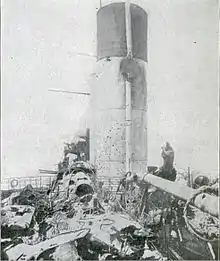
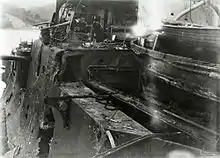

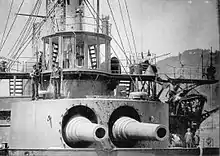

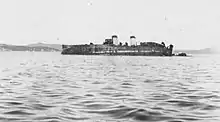

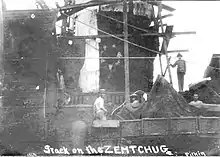
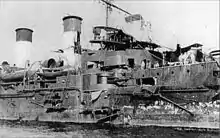
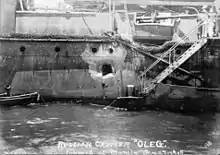
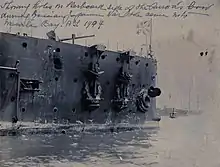
| Russian 2nd. & 3rd. Pacific Fleet[81] |
Primary Armament | Water Line/Turret Armor | Disp./Length | Speed in Knots | Damage/Casualties/Remarks |
|---|---|---|---|---|---|
| Launched/Builder | |||||
| Oslyabya, battleship |
4 10-inch guns 11 6-inch guns |
9 inches 9 inches |
14,639tons/132.4m 1898/Russia |
18.3 | First modern battleship sunk by gunfire alone, sunk at 15:10 27 May. She was the flagship for the fleet's second in command, Rear Admiral von Fölkersahm, who had died 3 days earlier.[lower-alpha 31] The Japanese and most of the Russian fleet were unaware of his death. Complement 771 officers and men. |
| Imperator Aleksandr III, battleship (Borodino class) |
4 12-inch guns 12 6-inch guns |
7 5/8 inches 10 inches |
14,409tons/121m 1901/Russia |
17.7 | Sunk by gunfire from enemy battle line at 18:50 27 May, complement 830 officers and men, 4 survivors.[83] |
| Knyaz Suvorov, battleship (Borodino class), fleet flagship |
4 12-inch guns 12 6-inch guns |
7 5/8 inches 10 inches |
14,646tons/121m 1902/Russia |
17.5 | Shot into a wreck. Sunk at 19:20 27 May. Destroyers were ordered to administer the coup de grace, "while she had a gun above water she fired...[Suvorov's] stubborn gallantry, no words can do justice. If there is immortality in naval memory it is hers and theirs." Of her 40 officers and 888 men there were no survivors[83] (except the injured Admiral Rozhestvensky and his staff who were rescued from the burning ship at 15:50 by destroyer Buyniy).[1]: p.83 [lower-alpha 32] |
| Borodino, battleship (Borodino class) |
4 12-inch guns 12 6-inch guns |
7 5/8 inches 10 inches |
14,317tons/121m 1901/Russia |
16.2 | Sunk at 19:30 27 May from a 12-inch Parthian shot from the battleship Fuji which detonated the ammo magazines, 1 survivor from a complement of 32 officers and 822 men.[83] |
| Oryol, battleship (Borodino class) |
4 12-inch guns 12 6-inch guns |
1-10 inches 5.7-7.64 inches |
14,378tons/121m 1902/Russia |
18 | Damaged seriously. Captured at 10:30 28 May under the command of Rear Admiral Nebogatov who surrendered to the Japanese after taking command from the injured Admiral Zinovy Rozhestvensky. Recommissioned as IJN Iwami after an extensive repair on 2 November 1907. Stricken 1 September 1922. Sunk as an air-raid target on 10 July 1924. |
| Navarin, battleship |
4 12-inch guns 8 6-inch guns |
16 inches 12 inches |
10,370tons/107m 1891/Russia |
15.9 | Sunk in the night of 27 May by destroyer torpedoes, 3 survivors from a complement of 674 officers and men. 1 man picked up by local fishing boat, 2 picked up by a British merchantman.[46] |
| Sissoi Veliky, battleship |
4 12-inch guns 6 6-inch guns |
16 inches 12 inches |
10,567tons/107.23m 1894/Russia |
15.7 | Sunk in the night of 27 May by destroyer torpedoes. 47 men lost, 42 officers and 571 men saved.[86] |
| Imperator Nikolai I, battleship flagship for 3rd Pacific Fleet |
2 12-inch guns 4 9-inch guns |
2.5-10 inches 6-14 inches |
9,748tons/105.61m 1889/Russia |
14 | Captured at 10:30 28 May as the flagship for the commander of the 3rd Pacific Fleet, Rear Admiral Nikolai Nebogatov, when he hoisted the flag signal "XGE P" meaning "Surrendered. Go still (proceeding slow)."[1]: p.119 Received one 12-inch, two 8-inch, and two 6-inch hits. 5 officers/men killed, 35 wounded. Recommissioned as IJN Iki. Stricken 1 May 1915. Sunk as a gunnery target for IJN Battleships Kongō and Hiei on 3 October 1915. |
| Admiral Ushakov, battleship[87] |
4 10-inch guns 4 4.7-inch guns |
10 inches 8 inches |
5,081tons/87.3m 1893/Russia |
16.1 | Arrived late at 15:00 28 May to the Nebogatov surrender site. She did not accept the signaled news of surrender and started firing while fleeing from the site. Shot into a wreck by Iwate and Yakumo, scuttled at 19:00 as she was already sinking. 12 officers and 339 men saved from her complement of 422 officers and men.[1]: pp.125–126 Her commander, Captain V. N. Miklukha-Maklai, refused help by the Japanese and went down with his ship.[88][lower-alpha 33] |
| Admiral Seniavin, battleship[87] |
4 10-inch guns 4 4.7-inch guns |
9.8 inches 3-7.9 inches |
4,232tons/84.6m 1894/Russia |
16 | Captured at 10:30 28 May following the surrender together with her sister-ship General-Admiral Apraksin, flagship Imperator Nikolai I, and the battleship Oryol.[1]: p.124 Admiral Seniavin became IJN Mishima, stricken 10 October 1935. Sunk as an air-raid target for IJN Hōshō on 5 May 1936. |
| General-Admiral Apraksin, battleship[87] |
3 10-inch guns 4 4.7-inch guns |
9.8 inches 3-7.9 inches |
4,165tons/80.62m 1896/Russia |
15 | Captured at 10:30 28 May following the surrender together with her sister-ship Admiral Seniavin, flagship Imperator Nikolai I, and the battleship Oryol.[1]: p.119 General-Admiral Apraksin became IJN Okinoshima, decommissioned 1 April 1922, used as a training ship for Sasebo Marine Corps until stricken in 1924. Sold in 1925, scrapped in 1939. |
| Admiral Nakhimov, armored cruiser |
8 8-inch guns 10 6-inch guns |
10 inches 8 inches |
7,906tons/103.3m 1885/Russia |
16.6 | Sunk in the night of 27 May by destroyer torpedoes. Over 600 men saved by lifeboats, local fishing boats, and armed merchant cruiser Sado Maru.[89] |
| Vladimir Monomakh, armored cruiser |
5 6-inch guns 6 4.7-inch guns |
6 inches - |
5,683tons/90.3m 1882/Russia |
15.8 | Sunk in the night of 27 May by destroyer torpedoes. 32 officers and 374 men rescued by armed merchant cruiser IJN Manshu (IJN Manshu was the Italian-built cruise-ship Manchuria owned and operated by the Russian Chinese Eastern Railway before the war). Complement 493 officers/men.[89] |
| Dmitrii Donskoi, armored cruiser |
6 6-inch guns 10 4.7-inch guns |
6 inches - |
5,976tons/93.4m 1883/Russia |
16.5 | Suffered severe damage during the day 27 May. Scuttled in the night 29 May by her crew in Matsushima Bay.[lower-alpha 34] They rowed to Matsushima Island and camped out. The island turned out to be a Japanese signal station, and they became POWs.[90] |
| Svetlana, protected cruiser |
6 6-inch guns 10 47mm Hotchkiss guns |
2 inches - |
3,924tons/101m 1896/France |
21 | Sunk at 10:50, 28 May by gunfire from IJN cruisers Niitaka, Otowa and destroyer Murakumo east of Jukbyeon Bay on the east coast of Korea.[lower-alpha 35] Estimated 169 men lost. 290 men (23 wounded) rescued by IJN Amerika Maru. |
| Izumrud, protected cruiser |
8 4.7-inch guns 4 47mm Hotchkiss guns |
1.3-3.0 inches 1.3 inches |
3,153tons/111m 1903/Russia |
24 | Ran aground outside of St. Vladimir Bay (300 km ENE of Vladivostok)[53][lower-alpha 36] in the night of 29 May. Destroyed by her crew. Complement of 350 eventually reached Vladivostok by land. |
| Ural, auxiliary cruiser |
2 4.7-inch 4 76mm guns 8 57mm Hotch. Guns[lower-alpha 37] |
N/A | 7,840tons/160m 1890/Germany |
20 | Sunk by the Japanese 1st Div. bombardment and a torpedo by battleship Shikishima at 17:51 on 27 May.[1]: pp.88–90 |
| Bezuprechni, torpedo boat destroyer |
3 torpedo tubes (carried 6 torpedoes) 1 3-inch gun 5 3-pounder guns |
N/A | 350tons/64m 1902/Russia |
26 | Sunk by gunfire on 28 May from IJN protected cruiser Chitose which expended 68 120mm, and 39 3-inch shells; joined later by IJN torpedo boat destroyer Ariake, which expended 12 rounds of her 3-inch shells at Bezuprechni.[91] |
| Buyniy, torpedo boat destroyer |
3 torpedo tubes (carried 6 torpedoes) 1 3-inch gun 5 3-pounder guns |
N/A | 350tons/64m 1901/Russia |
26 | Shot into a wreck during the day 27 May.[lower-alpha 32] Kingston valves opened, and then she was sunk by gunfire from the armored cruiser Dmitrii Donskoi on 28 May.[92] Survivors of Buyniy onboard Dmitrii Donskoi paddled ashore with the rest of the men to Matsushima Island when Donskoi went down on 29 May.[94] |
| Gromkiy, torpedo boat destroyer |
3 torpedo tubes (carried 6 torpedoes) 1 3-inch gun 5 3-pounder guns |
N/A | 420tons/64m 1904/Russia |
26 | IJN torpedo boat destroyer Shiranui duelled with Gromkiy on 28 May for over an hour at ranges from 4,000 to 5,000 meters. Destroyer Shiranui was equipped with 2 3-inch guns and 4 6-pounder guns, 2 torpedo tubes and 4 torpedoes, with a complement of 52 men. IJN Torpedo Boat #63 arrived, and Gromkiy surrendered. Japanese prize crew boarded Gromkiy, but she was so heavily damaged that she began to sink, forcing the prize crew to quickly abandon ship. She rolled over and sank at 1243 hrs.[95] |
| Blestyashchiy, torpedo boat destroyer |
3 torpedo tubes (carried 6 torpedoes) 1 3-inch gun 5 3-pounder guns |
N/A | 440tons/64m 1901/Russia |
26 | Took active role in rescuing survivors of Oslyabya, and received an 8-inch hit while doing so during the day action 27 May. This hit killed the commander, Alexander Sergeevich Shamov. Scuttled after the crew and eight Oslyabya survivors were transferred to Byedoviy on 28 May. 3 men lost.[lower-alpha 38] |
| Bistriy, torpedo boat destroyer |
3 torpedo tubes (carried 6 torpedoes) 1 3-inch gun 5 3-pounder guns |
N/A | 350tons/64m 1901/Russia |
26 | Accompanied Svetlana to the end. Fired upon and chased by cruisers Niitaka, Otowa and destroyer Murakumo. Destroyed after running ashore[53] north of Jukbyeon Bay[lower-alpha 39] on 28 May by her crew, who surrendered to the Japanese Jukbyeon signal station guards. |
| Byedoviy, torpedo boat destroyer |
3 torpedo tubes (carried 6 torpedoes) 1 3-inch gun 5 3-pounder guns |
N/A | 350tons/64m 1903/Russia |
26 | Surrendered and captured by IJN Destroyer Sazanami in the late afternoon on 28 May with Admiral Rozhestvensky and over 80 of his men (staff) onboard according to a Japanese Navy record.[1]: p.152 [lower-alpha 32] Byedoviy became IJN Satsuki, stricken 1 April 1913, BU 1921.[lower-alpha 40] |
| Irtysh, Auxiliary |
8 3-pounder guns | N/A | 15,000tons/180m 1900/Germany |
10.5 | Foundered by battle damage and abandoned 2 nm off the Japanese coast of Shimane on 28 May. Sank before dawn 29 May. All 235 onboard including Captain Gomuycev were rescued by the residents of Waki town.[96][97][lower-alpha 41] |
| Kamchatka, Repair ship |
6 47mm Hotchkiss guns |
N/A | 7,200tons/76.25m 1902/Russia |
12 | Shot into a wreck by the Japanese 1st Div. at 17:36, sunk by Sixth Div.[lower-alpha 8] at 19:30 on 27 May.[1]: p.89 |
| Rus, Ocean tug |
N/A | N/A | 611tons/51.4m 1903/Russia |
10 | Sunk by Japanese cruisers after being rammed by Russian supply ship Anadyr on 27 May.[98] |
The Russian cruiser Almaz and two torpedo boat destroyers Grozniy and Braviy reached Vladivostok.[99] Protected cruisers, Aurora, Zhemchug, and Oleg, escaped to the U.S. Naval Base Subic Bay in the Philippines, and were interned.[100] Destroyer Bodriy, ammunition ship Koreya, and ocean tug Svir were interned in Shanghai. Auxiliary Anadyr escaped to Madagascar. Hospital ships Orel and Kostroma were captured by the Japanese. Kostroma was later released.[lower-alpha 43] consequently, Orel was kept as a prize of war by Japan.[51]</ref>


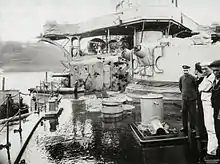
| Japanese Combined Fleet[1] | Primary Armament | Water Line/Turret Armor | Disp./Length | Speed In Knots | Damage/Casualties/Remarks |
|---|---|---|---|---|---|
| Launched/Builder | |||||
| Mikasa, battleship fleet flagship |
4 12-inch guns 14 6-inch guns |
9 inches 14 inches |
15,140tons/131.7m 1900/Great Britain |
18.5 | Took over 30 large-calibre hits; ventilators and funnels holed, armor penetrated in several places, top part of rear mast lost; over 100 casualties, complement 875 officers/men.[101] |
| Shikishima, battleship |
4 12-inch guns 14 6-inch guns |
9 inches 14 inches |
14,850tons/133.5m 1898/Great Britain |
19 | Several large-calibre hits in the total of nine times. Lost one 12-inch gun barrel to a "burst" (barrel exploded).[102] |
| Fuji, battleship |
4 12-inch guns 10 6-inch guns |
18 inches 14 inches |
12,533tons/114m 1896/Great Britain |
18.5 | Several large-calibre hits in the total of 12 times. Lost eight men and nine wounded.[103] One 12-inch gun barrel shot off by a 12" shell from Imperator Nikolai I.[102] |
| Asahi, battleship |
4 12-inch guns 14 6-inch guns |
9 inches 14 inches |
15,200tons/129.62m 1899/Great Britain |
18.3 | A few large-calibre hits in the total of 6 hits.[104] Complement 835 officers/men, lost 1 officer and 6 men, 5 men seriously wounded, 1 officer and 18 men lightly wounded.[1]: pp.98–106 |
| Kasuga, armored cruiser |
1 10-inch gun 2 8-inch guns 14 6-inch guns |
5 1/2 inches 5 1/2 inches |
7,700tons/105m 1902/Italy |
20.1 | One 12-inch, one 6-inch, and one unidentified hits.[105] Complement 609 officers/men. |
| Nisshin, armored cruiser flagship of 1st Div.[lower-alpha 8] |
4 8-inch guns 14 6-inch guns |
5.9 inches 5.9 inches |
7,700tons/105m 1903/Italy |
20.2 | Hit by 6 twelve-inch, 1 nine-inch, 2 six-inch and 4 unidentified shells.[106][lower-alpha 44] Two 8-inch gun barrels shot off, another 8-inch gun lost to a "burst". The 1st Div. command, Vice Admiral Misu Sōtarō, seriously injured, his Chief of Staff, Commander Matsui Kenkichi killed. Complement 609 officers/men; 50 casualties.[102] |
| Asama, armored cruiser (2nd Div.) |
4 8-inch guns 14 6-inch guns 5 torpedo tubes |
3.5-7 inches 6.3 inches |
9,710tons/134.7m 1898/Great Britain |
22.1 | Hit by a 12" shell at 14:27 on 27 May, which took her steering mechanism out of order, and she fell out of formation. Received three 12", two 8", and about seven smaller hits. Lost 11 men, injured 13 out of the complement of 676. |
| Kasagi, armored cruiser 3rd Div. flagship[lower-alpha 8] |
2 8-inch guns 10 12cm guns 5 torpedo tubes |
- 4.5 inches |
4,862tons/114.1m 1898/U.S.A. |
22.5 | Japanese 3rd Div. engaged Oleg, Aurora and Zhemchug at about 14:30 27 May, and the flagship Kasagi received a 6" hit below waterline where she does not have armor plates. This hit flooded a boiler room and a coal bunker killing one and injured nine men, which necessitated a repair. Kasagi and her American-built sister Chitose withdrew from the battle and Vice Admiral Dewa Shigetō moved his flag to Chitose. Complement of 405. |
| Harusame, torpedo boat destroyer First Destroyer Div. lead ship[lower-alpha 8] |
2 3-inch guns 4 57mm guns 2 torpedo tubes |
N/A | 375tons/69.2m 1902/Japan |
29 | In the confusion of the night attack on 27 May, Harusame collided with Yūgiri and incurred a serious flooding but avoided sinking. Complement 62. |
| Yūgiri, torpedo boat destroyer (Fifth Destroyer Div.)[lower-alpha 8] |
1 8cm gun 5 57mm guns 2 torpedo tubes |
N/A | 322tons/63.6m 1899/Great Britain |
30 | During the night of 27 May, Yūgiri collided with the fellow destroyer Harusame, seriously damaging the bow. She avoided sinking and limped back to Sasebo on 28 May. Complement 58. |
| Torpedo Boat #34 | 1 3-pounder gun 3 torpedo tubes |
N/A | 83tons/39m 1899/Germany |
24 | Sunk by Russian gunfire, 27 May. This boat belonged to Takeshiki Guard District outside of the Combined Fleet. |
| Torpedo Boat #35 | 1 3-pounder gun 3 torpedo tubes |
N/A | 83tons/39m 1899/Germany |
24 | Sunk by Russian gunfire, 27 May. This boat belonged to Takeshiki Guard District outside of the Combined Fleet. |
| Torpedo Boat #69 | 2 3-pounder guns 3 torpedo tubes |
N/A | 89tons/40.1m 1902/Japan |
24 | Sunk in the midst of a torpedo attack in the night of 27 May, after colliding with IJN torpedo boat destroyer Akatsuki. Akatsuki (later renamed Yamabiko) was a Russian prize from Battle of the Yellow Sea, captured on 12 August 1904, the ex-Ryeshitelni.[107] |
Russian losses
Total Russian personnel losses were 216 officers and 4,614 men killed; with 278 officers and 5,629 men taken as Prisoners Of War (POW). Interned in neutral ports were 79 officers and 1,783 men. Escaping to Vladivostok and Diego-Suarez were 62 officers and 1,165 men. Japanese personnel losses were 117 officers and men killed and 583 officers and men wounded.[99]
The battle was humiliating for Russia, which lost all its battleships and most of its cruisers and destroyers. The battle effectively ended the Russo-Japanese War in Japan's favour. The Russians lost 4,380 killed and 5,917 captured with a further 1,862 interned.[52] Two admirals, Rozhestvensky and Nebogatov, were captured by the Japanese Navy. The second in command of the fleet, Rear Admiral Dmitry Gustavovich von Fölkersahm, after suffering a cerebral hemorrhage on 16 April, died in the night of 24 May 1905 onboard battleship Oslyabya.[51] Vice Admiral Oskar Enqvist fled to Manila onboard cruiser Oleg and was interned by the United States.
Battleships
The Russians lost eleven battleships, including three smaller coastal battleships, either sunk or captured by the Japanese, or scuttled by their crews to prevent capture. Four were lost to enemy action during the daylight battle on 27 May: Knyaz Suvorov, Imperator Aleksandr III, Borodino and Oslyabya. Navarin was lost during the night action on 27–28 May, while the Sissoi Veliky and Admiral Ushakov[100] were either scuttled or sunk the next day. Four other battleships, under Rear Admiral Nebogatov, were forced to surrender and would end up as prizes of war. This group consisted of only one modern battleship, Oryol, along with the old battleship Imperator Nikolai I and two small coastal battleships General Admiral Graf Apraksin and Admiral Seniavin.[100]
Cruisers
The Russian Navy lost five of its nine cruisers during the battle, three more were interned by the Americans, with just one reaching Vladivostok. Vladimir Monomakh and Svetlana were sunk the next day after the daylight battle. The cruiser Dmitrii Donskoi fought against six Japanese cruisers and survived; however, she was scuttled on 29 May 1905 due to heavy damage. Izumrud ran aground on the Siberian coast.[100] Three Russian protected cruisers, Aurora, Zhemchug, and Oleg, escaped to the U.S. naval base at Manila[100] in the then-American-controlled Philippines where they were interned, as the United States was neutral. The armed yacht (classified as a cruiser) Almaz, alone was able to reach Vladivostok.[108]
Destroyers and auxiliaries
Imperial Russia also lost six of its nine destroyers in the battle, had one interned by the Chinese, and the other two escaped to Vladivostok. They were – Buyniy ("Буйный"), Bistriy ("Быстрый"), Bezuprechniy ("Безупречный"), Gromkiy ("Громкий") and Blestyashchiy ("Блестящий") – sunk on 28 May, Byedoviy ("Бедовый") surrendered that day. Bodriy ("Бодрый") was interned in Shanghai; Grozniy ("Грозный") and Braviy ("Бравый") reached Vladivostok.
Of the auxiliaries, Kamchatka, Ural and Rus were sunk on 27 May, Irtuish ran aground on 28 May, Koreya and Svir were interned in Shanghai; Anadyr escaped to Madagascar. The hospital ships Orel and Kostroma were captured; Kostroma was released afterwards.[lower-alpha 43]
Japanese losses
The Japanese lost three torpedo boats (Nos. 34, 35 and 69). Total casualty of 117 men killed and 500 wounded.[52]
Political consequences
Imperial Russia's prestige was badly damaged and the defeat was a blow to the Romanov dynasty. Most of the Russian fleet was lost; the fast armed yacht Almaz (classified as a cruiser of the 2nd rank) and the destroyers Grozny and Bravy were the only Russian ships to reach Vladivostok.[108] In The Guns of August, the American historian and author Barbara Tuchman argued that because Russia's loss destabilized the balance of power in Europe, it emboldened the Central Powers and contributed to their decision to go to war in 1914.[109]
The battle had a profound cultural and political impact in the world. It was the first defeat of a European power by an Asian nation in the modern era.[110][111] It also heightened the alarm of "The Yellow Peril" as well as weakening the notion of white superiority that was prevalent in some Western countries.[112][113] Mahatma Gandhi (India), Mustafa Kemal Atatürk (Turkey), Sun Yat-sen (China) and Jawaharlal Nehru (India) were amongst the future national leaders to celebrate this defeat of a colonial power.[114] The victory established Japan as the sixth greatest naval power[115] while the Russian navy declined to one barely stronger than that of Austria-Hungary.[115]
In The Guinness Book of Decisive Battles, the British historian Geoffrey Regan argues that the victory bolstered Japan's increasingly aggressive political and military establishment. According to Regan, the lopsided Japanese victory at Tsushima:
...created a legend that was to haunt Japan's leaders for forty years. A British admiral once said, 'It takes three years to build a ship, but 300 years to build a tradition.' Japan thought that the victory had completed this task in a matter of a few years ... It had all been too easy. Looking at Tōgō's victory over one of the world's great powers convinced some Japanese military men that with more ships, and bigger and better ones, similar victories could be won throughout the Pacific. Perhaps no power could resist the Japanese navy, not even Britain and the United States.[52]
Regan also believes the victory contributed to the Japanese road to later disaster, "because the result was so misleading. Certainly the Japanese navy had performed well, but its opponents had been weak, and it was not invincible... Tōgō's victory [helped] set Japan on a path that would eventually lead her" to the Second World War.[52]
Takano Isoroku, the future Japanese admiral Yamamoto Isoroku who would plan the attack on Pearl Harbor and command the Imperial Japanese Navy through much of the Second World War, served as a junior officer (aboard Nisshin) during the battle and was wounded and lost two fingers by an accidental explosion of an 8" shell in a forward gun. Had he lost a third, he would have been medically discharged from the IJN.
Dreadnought arms race
Britain's First Sea Lord, Admiral Jackie Fisher, reasoned that the Japanese victory at Tsushima confirmed the importance of large guns and speed for modern battleships.[116][117] While Captain William Pakenham of the British Royal Navy, who had been present aboard the Japanese battleship Asahi as an official observer during the Tsushima Battle, "famously remarked...the effect of the fire of every gun is so much less than that of the next larger size, that when 12in guns are firing, shots from 10in pass unnoticed...everything in this war has tended to emphasize the vast importance to a ship, at every stage of her career, of carrying some of the heaviest and furthest shooting guns that can be got into her."[118] In October 1905 the British started the construction of HMS Dreadnought, which marked the beginning of a naval arms race between Britain and Germany in the years before 1914.[119]
The battle also accelerated the naval arms race on a geopolitical level; though the Anglo-German naval arms race had begun in 1897, the collapse of Russian naval power in 1905 allowed Britain to send the bulk of its naval forces to other regions, reassured by the naval superiority of its ally Japan in the Far East. In turn, the presence of a larger British fleet in Europe meant that the Germans must build a proportionally larger fleet to maintain the same relative power, in accordance with Tirpitz' fleet in being principle. The Royal Navy, in turn, must increase its fleet size to maintain the relative power as set out by its two-power standard. This positive feedback meant that any external increase in the regional naval power of one side - in this case, the British - would precipitate not just a proportional increase in naval power from the opposing side, but rather a mutual multi-stage build-up in naval power on both sides, before settling to a higher equilibrium. Ultimately, the Germans passed three of its five Fleet Acts after Tsushima within a span of 6 years.
Upon the breakout of World War I, the British and Germans were both aware of the potentially devastating consequences of a naval defeat on the scale of Tsushima. Britain needed its battle fleet to protect its empire, and the trade routes vital to its war effort. Winston Churchill, then First Lord of the Admiralty, described British Admiral John Jellicoe as "the only man who on either side could lose the war in an afternoon."[120] German naval commanders, for their part, understood the importance Kaiser Wilhelm II attached to his navy and the diplomatic prestige it carried. As a result of caution, the British and German fleets met in only one major action in World War I, the indecisive Battle of Jutland.
Timeline
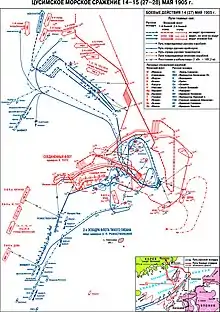
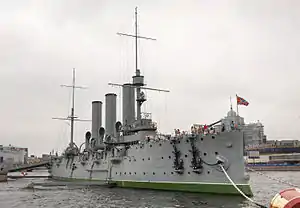


27 May 1905 (JST)[121][1][122]
- 04:45 The Shinano Maru (Japan) locates the Russian Baltic Fleet and sends a wireless message "Spotted enemy in grid 203" to cruiser Itsukushima, which relays it to the Combined Fleet flagship Japanese battleship Mikasa.
- 06:05 The 1st (Japanese battleship Mikasa, Shikishima, Fuji, Asahi, Kasuga, Nisshin), 2nd (Izumo, Azuma, Tokiwa, Yakumo, Asama, Iwate) and 4th (Naniwa, Takachiho, Akashi, Tsushima) battle divisions[lower-alpha 8] of the Japanese Combined Fleet leave mooring in Jinhae (Chinhae, or Chinkai) Bay[lower-alpha 45] head East at 15 knots. "Weather is half-cloudy, wind from the South West, wave is still high from the stormy weather in the last two days."
- 07:00 Cruiser Izumi relieves Shinano Maru of reporting task and shadows the Baltic Fleet alone, reports "Enemy fleet is in grid 224 (20 n.miles NW of Ukushima Island, Nagasaki) heading North North East".
- 10:00 Mikasa sends a wireless message to the Imperial General Headquarters: "Upon receiving its spotting report, Combined Fleet is going into battle with enemy fleet today near Okinoshima Island. Today's weather is fine but waves are high. (Japanese: 本日天気晴朗なれども波高し)".
- 10:30 The 5th battle division (Itsukushima, Matsushima, Hashidate, Chin'en) makes contact with the Baltic Fleet. Stays with the fleet on its right flank.
- 11:00 Details of Russian fleet formation is assembled: "Right (East) flank, 1st column Destroyers, 2nd column Knyaz Suvorov, Borodino-class, Borodino-class, Borodino-class, Oslyabya, Sissoi Veliky, Navarin, Nakhimov; 3rd and 4th columns (slightly behind) Transports and Auxiliaries guarded by destroyers; 5th column (Left flank -West) Nikolai I, Admiral-class Coastal Battleship, Admiral-class, Admiral-class, Oleg, Aurora, Donskoi, Monomakh"
- 11:30 The 3rd battle division (Kasagi, Chitose, Otowa, Niitaka) makes contact with the Baltic Fleet. Stays with the fleet on its left flank.
- 11:55 Tōgō gathers all hands on Mikasa rear deck, tells the known situation, and says "Accurate aim on all the shots is the foremost and the only wish I have at this moment."[122]: p.1
- 12:00 Mikasa's chief navigation officer[lower-alpha 46] records the current coordinates, 34°27′N 130°1′E.[122]: p.1
- 12:00 Russian fleet starts shifting formations. Kasagi and Itsukushima report all the details in radio telegrams: "Right flank Suvorov and 3 Borodino-class; Left flank Oslyabya, Veliky, Navarin, Nakhimov, Nikolai I and Admiral-class ships."
- 12:30 The 6th battle division (Suma, Izumi, Chiyoda, Akitsushima) tails the Baltic Fleet.
- 12:38 "Battle stations" ordered on Mikasa.[122]: p.2
- 13:15 The Japanese main group (Mikasa, Shikishima, Fuji, Asahi, Kasuga, Nisshin and the 2nd battle division in this order) gains visual contact.
- 13:30 The Russian main group (Suvorov, Aleksandr III, Borodino and Oryol in this order) shifts heading Left (to North) to cover the Left column led by Oslyabya.
- 13:39 Mikasa hoists the battle flag, heading SSW approaching the West side of Russian Left flank.
- 13:54 Mikasa to the closest Russian ship, Oslyabya: 12,000 yards. Mikasa sends up 'Z' flag, meaning "The Empire's fate depends on the result of this battle, let every man do his utmost duty."
- 14:00 Mikasa to Oslyabya: 10,000 yards. Mikasa turns her helm aport and starts a U-turn with the 5 ships following in sequence to head NNE.
- 14:03 Shikishima to Oslyabya: 9,000 yards. As Shikishima starts to turn, Oslyabya opens fire.
- 14:07 Fuji to Oslyabya: 8,200 yards. Fuji completes her turn. Knyaz Suvorov and the Russian Baltic Fleet open fire with their main batteries.
- 14:10 Asahi to Oslyabya: 7,300 yards. Asahi completes her turn. Mikasa opens fire on Oslyabya with a salvo 6" test shot to establish distance baseline.[122]: p.2 [lower-alpha 47]
- 14:12 Kasuga to Oslyabya: 6,500 yards. Mikasa receives her first hit from the Russian guns. Shikishima, Fuji, Asahi, Kasuga and Nisshin open fire on Oslyabya.
- 14:14 Nisshin to Oslyabya: 6,000 yards. Oslyabya loses her front mast and the center stack.
- 14:15 Oslyabya catches major fire and slows down.
- 14:19 Mikasa to Suvorov: 5,800 yards. Japanese main group begins concentrating their fire on the Russian flagship, Knyaz Suvorov, which is now leading the Left column heading NNE.
- 14:25 Mikasa loses top part of rear mast.[lower-alpha 48] Mikasa and her line turns NE and then to East to "cross the T". Russian Left column turns NE and to ESE in response.
- 14:43 Knyaz Suvorov is set on fire and fall away from the battle line.
- 14:50 Aleksandr turns to the North with Borodino and Oryol following, in an apparent attempt to leave the battle line.
- 14:55 Mikasa and the 5 ships make immediate U-turn Left on the spot and heads WNW in reverse order (Nisshin first, Mikasa last).
- 15:10 Nisshin to Aleksandr: 4,000 yards. Oslyabya sinks. Knyaz Suvorov attempts to withdraw.
- 15:14 Asahi to Aleksandr: 3,000 yards. Aleksandr, apparently giving up fleeing North, turns SE with Borodino and Oryol following.
- 15:18 Asahi to Borodino: 2,500 yards.
- 15:50 Nisshin and the 5 ships make another immediate U-turn Left, heads NE in normal order (Mikasa first, Nisshin last). Japanese main group loses sight of the Russian main group in the mist.
- 17:51 Russian auxiliary cruiser Ural sunk by the 1st battle division bombardment and a torpedo by battleship Shikishima.[123]
- 18:03 Mikasa and the main group finds the remainder of the Russian main group and concentrates fire on the leading Aleksandr III.
- 18:16 Aleksandr catches major fire. Japanese main group concentrates fire on Borodino.
- 19:03 Imperator Aleksandr III sinks.
- 19:04 Huge explosion occurs in Borodino's stern.
- 19:20 Knyaz Suvorov sinks.
- 19:30 Borodino sinks. Russian repair ship Kamchatka sinks. Japanese 1st battle division leaves the battle ground.
- 05:23 The scout ship of the 5th battle division, Yaeyama, sends "Spotted enemy in grid 603 heading NE" to Itsukushima.
- 05:30 The Japanese Combined Fleet starts assembling a surrounding formation with over 20 capital ships among all the battle divisions.
- 09:30 Formation is mostly in place. Mikasa and the 1st battle division approach from the North heading South.
- 10:00 Izumrud turns South and runs at high speed away from the rest of the Russian fleet.
- 10:31 Mikasa opens fire at 10,000 yards to Nikolai I with Oryol, Apraksin and Seniavin following in this order.
- 10:34 Admiral Nebogatov signals "XGE P", which is "Surrendered. Go still (Proceeding slow)" in the International Code of Signals used at the time.
- 10:42 Kasuga hoists flag signal "enemy surrendered".
- 10:45 Admiral Tōgō accepts the surrender. Cruiser Svetlana sunk by the 3rd battle division on its way North to the surrounding formation.
- 10:53 Firing stops.
_J.PNG.webp) Crossing the T: Japanese are in white, the Russians in red. At this point, Second Battle Div. followed the wake of First Battle Div.
Crossing the T: Japanese are in white, the Russians in red. At this point, Second Battle Div. followed the wake of First Battle Div._J.PNG.webp) Oslyabya and Knyaz Suvorov are damaged and breaking off. Imperator Aleksandr III, Borodino, and Oryol turn North, fleeing from the out-running Japanese divisions.
Oslyabya and Knyaz Suvorov are damaged and breaking off. Imperator Aleksandr III, Borodino, and Oryol turn North, fleeing from the out-running Japanese divisions._J.PNG.webp) The Japanese first and second divisions sandwiching the Russian fleet.
The Japanese first and second divisions sandwiching the Russian fleet._J.PNG.webp) The Russian ships in a shambles.
The Russian ships in a shambles.
On film
The battle has been the main focus for two historical films in Japan. The first, 1969's Battle of the Japan Sea (日本海大海戦, Nihonkai Daikaisen), directed by Seiji Maruyama, starring Toshiro Mifune as Admiral Tōgō, with music by Masaru Sato and special effects by Eiji Tsuburaya. It was dramatized again in 1983's Battle Anthem (日本海大海戦・海ゆかば, Nihonkai Daikaisen—Umi Yukaba) with Mifune reprising his role.
Another, more recent, depiction is episode 4, season 3 of the 2009–2011 NHK taiga drama series Saka no Ue no Kumo (坂の上の雲) (lit. "Clouds Above the Slope").
See also
- Order of battle at the Battle of Tsushima
- Imperial Japanese Navy#Naval Buildup and tensions with Russia
- Baltic Fleet#Russo-Japanese War
- Military attachés and observers in the Russo-Japanese War
- Naval history of Japan
- Nicholas II of Russia
Explanatory notes
- This painting shows Tōgō wearing a sword. In reality, it was prohibited for any officer to wear a sword on this deck for its effect on compass reading. The cushion-like coverings on the compass turret and side railings are rolled sailor hammocks (rolled canvas awnings on the mast) as a part of the "prepare for battle" procedure to reduce the risk of shrapnel.[1]: pp.49–51
- He ended up being enshrined as a deity at Tōgō Shrine later in 1940.
- The Baltic Fleet left Russia in four groups, commanded by Admiral Rozhestvensky, Rear Admiral von Fölkersahm, Rear Admiral Nevogatov and Captain Leonid Dobrotvorsky. Later, illness incapacitated Fölkersahm and his eventual death just 3 days before the Battle of Tsushima promoted Rear Admiral Nobogatov to de facto Second in Command of the fleet.
- The Hamburg-American Steamship Line refused to provide coaling beyond French Indochina.[51]
- A captured British transport Oldhamire with Russian officers and some Russian crew was sent East as a diversion ploy to head for La Pérouse.[27]: Book 2, Part 4
- In one such trial, of the seven torpedoes fired, one jammed in the tube, two veered ninety degrees to port, one went ninety degrees to starboard, two kept a steady course but went wide of the mark, and the last went round in circles 'popping up and down like a porpoise', causing panic throughout the fleet." Regan 1992, p. 176
- Admirals Dewa (Battle of Port Arthur and Battle of the Yellow Sea), Kataoka (Battle of the Yellow Sea), Uryū (Battle of Chemulpo Bay), Kamimura (Battle of Port Arthur and Battle off Ulsan) and himself.
- See Order of battle at the Battle of Tsushima.
- 21 destroyers and 31 torpedo boats of the Combined Fleet, 4 torpedo boats from Kure Naval District, and 10 torpedo boats from Takeshiki Guard District.[lower-alpha 8]
- After the war, Admiral Rozhestvensky was asked in a Russian court martial why he chose day time to pass the most dangerous zone of Tsushima Strait. His answer was "Because torpedo boats in the night is a greater risk for battleships."
- See Russian battleship Oryol#Construction and career
- Oryol had lost the Left front main gun, and the rear Left gun could no longer be raised to extended-range elevations.[lower-alpha 11] So he had only four 12-inch guns left in the fleet, 2 older black-powder firing (shorter range) guns on Imperator Nikolai I and 2 newer longer range guns on the damaged Oryol that had lost both of the two rangefinders. See the #Gun range and rate of fire section for details.
- During Nebogatov's court martial, his defense for surrendering his battle fleet was because his guns were outranged by the Japanese guns.
- 35.480815°N 135.374341°E
- See Russian battleship Oryol#Construction and career for details. Due to her position in the Russian formation being the last in line of four Borodino-class battleships, Oryol probably received the least number of large calibre shells and possibly the most number of small calibre hits among the four.
- Large calibre long barrel rifle with special mounts to be centered in the bore
- During the 11-day period from 28 March to 7 April 1905, Mikasa had 5 days with gunnery training sessions. In these 5 days, Mikasa fired 9,066 rounds of practice ammunition.
- As an indication of unusually high level of gunnery training Tōgō applied to the fleet, the Maizuru Naval Arsenal requested an increase in 1905 fiscal year budget for additional 40,000 rounds of sub-calibre practice ammunition on 17 May 1905 for Mikasa, 34,000 rounds for cruiser Nisshin, 1,000 rounds per gun for destroyer Sazanami, among others, as they depleted annual allocations merely one and a half months into the fiscal year (Fiscal years begin on 1 April). These requests were all approved by the Fleet Management Dept. of the Naval Ministry for the entire fleet.[55]
- See the articles on Russian battleship Knyaz Suvorov, Russian battleship Oryol, and Russian battleship Imperator Aleksandr III.
- Launched on 29 August 1903. The last of Borodino-class ships.
- See #British support
- Baselength is the distance between the left and the right lens or mirror facing the target, which largely determines the effective range of a rangefinder.
- (1866-1938) Graduated from Tokyo University, Physics Dept.; studied at Harvard and Yale from 1893 to 1896. ja:木村駿吉
- See Adolf Slaby and Georg von Arco.
- Shimose Masachika also experienced an accidental explosion in 1887 and had lost dexterity on the left fingers. ja:下瀬雅允
- On Christmas day on Julian Calendar in 1904 off Madagascar, Alexey Novikov-Priboy (aka Vladimir Semenoff) onboard battleship Oryol wrote: "At noon, the ocean expanse was filled with the thunder of guns. Each ship fired a salute of thirty-one shots. The squadron was enveloped in black powder smoke."[27]
- 12" shells creating an "incomparably larger splash than the enemy's on the water"[1]: p.75
- 12" shells creating a "tall splash of 10–20m"[1]: p.74
- These shells held 5.3 kg[77] of guncotton, compared to 19.3 kg of Shimose powder for the Armstrong 12".[78]
- Battleship Shikishima still experienced this problem and lost a gun in the battle.
- See #Russian losses
- Destroyer Buyniy made a heroic rescue of the injured Admiral Rozhestvensky and his staff from the destroyed and burning battleship Knyaz Suvorov at 15:50 on 27 May, but she suffered severe damage in doing so. Admiral Rozhestvensky and the staff were transferred to Destroyer Byedoviy before she sank.
- See ru:Адмирал Ушаков (броненосец).
- 37.4915276°N 130.9197994°E
- 37.1°N 129.833333°E See Russian cruiser Svetlana (1896)#Russo-Japanese War.
- 40.4639063°N 133.0362708°E
- See ru:Урал (вспомогательный крейсер)
- See ru:Блестящий (миноносец)
- 36.751956°N 129.468349°E
- See ja:皐月 (戦利駆逐艦) for details.
- 35.002558°N 132.193921°E
- Convention (III) for the Adaptation to Maritime Warfare of the Principles of the Geneva Convention of 22 August 1864. The Hague, 29 July 1899., which defines Hospital Ships to be "solely for the purpose of assisting the wounded, sick or shipwrecked".<ref>"Article 1". Archived from the original on 24 May 2022. Retrieved 24 May 2022.
- At 22:45 on 18 May 1905, the Baltic Fleet spotted and conducted a boarding inspection on a British transport vessel, SS Oldhamire, that was sailing alongside the fleet. As Oldhamire was carrying 150,000 cans of oil destined for Japan, she became subject of a maritime capture, and was forced to join the fleet with Russian officers onboard. The removed captain, the chief engineer, and two more British personnel were kept in captivity onboard the hospital ship Orel. This imprisonment of 3rd-country nationals violated the international maritime agreements for hospital ships;[lower-alpha 42] See Hague Convention on Hospital Ships for signatory countries (note the absence of the UK).
- These were the most hits received after Mikasa.
- 35.070744°N 128.675710°E
- Nunome Mitsuzō, later Admiral. ja:布目満造
- Japanese navy had found the 6" guns to be more accurate than 12" guns, and formalized the procedure to use a 6-inch salvo firing for initial establishment of distance.
- Mikasa lost radio transmission capability with the loss of antenna. From this point on, Tōgō relied on hand semaphore signaling to the immediately following Shikishima for orders to be transmitted by radio.
Citations
- Tsukamoto Yoshitane (June 1907). Imperial Japanese Navy Records (ed.). "Battle of the Sea of Japan as seen from Battleship Asahi" (in Japanese). Sorokaku Publishing. Archived from the original on 2 April 2016. Retrieved 19 May 2022.
- Dougherty, Martin J., ed. (2012). 100 Battles that Shaped the World. Bath: Parragon. pp. 144–145. ISBN 9781445466804.
- Sterling, Christopher H. (2008). Military communications: from ancient times to the 21st century. ABC-CLIO. p. 459. ISBN 978-1-85109-732-6. Archived from the original on 25 May 2020. Retrieved 13 February 2016.
The naval battle of Tsushima, the ultimate contest of the 1904–1905 Russo-Japanese War, was one of the most decisive sea battles in history.
- Naval War College Press (U.S.), ed. (2009). Joint Operational Warfare Theory and Practice and V. 2, Historical Companion. Government Printing Office. p. V-76. ISBN 978-1-884733-62-8.
In retrospect, the battle of Tsushima in May 1905 was the last "decisive" naval battle in history.
- Brown 1990, p. 10.
- Semenoff 1907, p. ix.
- Morris, Edmund (2001). Theodore Rex. New York: Random House. ISBN 0-394-55509-0.
- Massie 1991, pp. 470–480.
- Semenoff 1907, pp. 125, 135.
- Sondhaus 2001, p. 188.
- Forczyk 2009, p. 48.
- Forczyk 2009, pp. 26, 54.
- Sondhaus 2001, p. 189.
- Busch 1969, p. 214.
- Sondhaus 2001, p. 190.
- Pleshakov 2002, p. 159.
- Willmott 2009, p. 112.
- Corbett 2015b, pp. 32–35.
- "Dogger Bank – Voyage of the Damned". Hullwebs – History of Hull. Archived from the original on 20 October 2008. Retrieved 8 September 2007.
- "The Russian navy's surprising losses against Ukraine are reminders of another humiliating defeat 117 years ago". Business Insider.
- Pleshakov, Constantine (2008). The Tsar's Last Armada: The Epic Voyage to the BATTLE of TSUSHIMA. Hachette UK. ISBN 9780786725496.
- Great Britain Committee of Imperial Defence (1920). Official history, naval and military, of the Russo-Japanese War. Prepared by the Historical section of the Committee of Imperial Defence. Vol. III. London: His Majesty's Stationery Office. pp. 27–31.
- Great Britain Committee of Imperial Defence (1920). Official history, naval and military, of the Russo-Japanese War. Prepared by the Historical section of the Committee of Imperial Defence. Vol. III. London: His Majesty's Stationery Office. pp. 27–31.
- "British Assistance to the Japanese Navy during the Russo-Japanese War of 1904-5". The Great Circle. Armidale: Australian Association for Maritime History. 2 (1): 44–54. April 1980. ISSN 0156-8698.
- "Battle of Tsushima | Russo-Japanese war". Encyclopedia Britannica.
- Corbett 2015b, pp. 152, 166–168.
- Novikov-Priboy.
- Forczyk 2009, p. 66.
- Forczyk 2009, p. 33
- Forczyk 2009, p. 32.
- Forczyk 2009, pp. 8, 43, 73 & back cover.
- Watts 1990, p. 22.
- Translated by Andrew Cobbing in Shiba Ryotaro, Clouds Above the Hill, volume 4, p. 212. Routledge, 2013.
- "After Terrible GDP Report, Japan Is Getting Ready To Calling A Snap Election". Business Insider. Archived from the original on 13 April 2016. Retrieved 5 July 2017.
- Admiral Tōgō's report on the Battle of Tsushima, as published by the Japanese Imperial Naval Headquarters Staff, September 1905; http://www.russojapanesewar.com/togo-aar3.html Archived 20 August 2010 at the Wayback Machine
- Koenig 1977, p. 141.
- Semenoff 1907, p. 70.
- Mahan 1906, pp. 457–458.
- Regan 1992, pp. 176–177.
- Mahan 1906, p. 458
- Busch 1969, pp. 150, 161, 163.
- Sondhaus 2001, p. 191.
- Semenoff 1907, pp. 62–63.
- Regan 1992, p. 177
- Busch 1969, pp. 159–160.
- Corbett 2015b, p. 304.
- Wright 1976, pp. 123–147.
- The Hutchinson Unabridged Encyclopedia with Atlas and Weather Guide. Credo Reference. ISBN 9781849727167.
- Busch 1969, p. 179.
- Lardas, Mark (2018). Tsushima 1905: Death of a Russian Fleet. Bloomsbury Publishing. p. 99. ISBN 9781472826855. Archived from the original on 25 June 2022. Retrieved 31 May 2021.
- Russian Naval General Staff, ed. (1 November 2004). Russo-Japanese Naval War Record, 1904-1905 (in Japanese). Translated by Hirama Yōichi. ISBN 4829503505.
- Regan 1992, p. 178
- Corbett 2015b, pp. 445.
- Forczyk 2009, pp. 43, 73.
- "Office of the Navy Minister, Record Nr.1963, 1905 (in Japanese)". Archived from the original on 11 May 2022. Retrieved 11 May 2022.
- McLaughlin 2003, pp. 136–143.
- Imperial Japanese Navy Records, Navy Office Intelligence Nr. 433, 12 November 1904 on page 0101, quoted a telegram dated 10 November 1904 from Consul Mitsuhashi (Mitsuhashi Nobukata, later Mayor of Yokohama City) at Copenhagen (also Consul of The Hague) stating "Two Danish harbor pilots who went onboard the flagship and Admiral Nakhimov in the Danish waters said the officers including the fleet commander seemed tense and irritable, while the crew appeared to be a bunch of fodders." https://www.jacar.archives.go.jp/aj/meta/image_C09050537400?IS_KIND=DetailSummary Archived 18 October 2020 at the Wayback Machine
- Forczyk 2009, p. 36.
- Imperial Japanese Navy Records, Report from Battleship Mikasa, Nr.205, Classified, 1904 (in Japanese)
- 8 March 1905 "Imperial Japanese Navy Records, Report from Battleship Mikasa (1-7)" (in Japanese). p. 50 (0355 in the original)., when Mikasa's succeeded Chief Gunnery Officer, Commander 3rd rank Wada Kōjirō, was assigned to Chief Gunnery Officer of Asahi.
- "British Assistance to the Japanese Navy during the Russo-Japanese War of 1904-5". The Great Circle. 2 (1): 44–54. 1980. JSTOR 41562319.
- Forczyk 2009, pp. 56–57.
- Busch 1969, pp. 137–138.
- Evans & Peattie 1997, p. 84.
- "AEG Radio receiver in the style of the Slaby Arco System". Archived from the original on 24 April 2022. Retrieved 24 April 2022.
- Brook, Peter (1999). Warships for Export: Armstrong Warships 1867–1927. Gravesend, Kent, UK: World Ship Society. ISBN 0-905617-89-4.
- Imperial Japanese Navy Records, Navy General Office Intelligence, 1904 Nr.418 on page 4 (page 0058 in the original) (in Japanese) https://www.jacar.archives.go.jp/das/image/C09050537400?IS_KIND=DetailSummary Archived 25 June 2022 at the Wayback Machine
- Corbett 2015b, pp. 142, 161, 193.
- Gray, Steven. "Fuelling mobility: coal and Britain's naval power, c. 1870–1914" (PDF). University of Portsmouth. Archived (PDF) from the original on 27 December 2021. Retrieved 26 October 2020.
- Horne 2015, p. 74.
- Mahan 1906, pp. 314–315.
- Koike, Shigeki (2006). "The Russo-Japanese War and the system of SHIMOSE gunpowder" (PDF). Bulletin of Papers (in Japanese). Takasaki City University of Economics. 1 (49). Archived (PDF) from the original on 5 March 2016. Retrieved 18 September 2020.
- Shimose Powder (in Japanese)
- Ijuin Fuse (in Japanese)
- Semenoff 1907, p. 63.
- Forczyk 2009, p. 15.
- Tony DiGiulian. "Russia / USSR 12"/40 (30.5 cm) Pattern 1895". NavWeaps. Retrieved 20 August 2022.
- Tony DiGiulian. "Japan 12"/40 (30.5 cm) EOC". NavWeaps. Retrieved 20 August 2022.
- See Armstrong Whitworth 12-inch 40-calibre naval gun for details.
- Corbett 2015b, pp. 445, 446.
- Corbett 2015b, Chapters X, XI, XIII, XIV.
- Corbett 2015b, p. 291
- Corbett 2015b, p. 308.
- British Naval Attache Reports 2003, p. 441. Note: Sometimes referred to as a coastal battleship, or armored coast defense vessel; Corbett 2015b, p. 420
- Corbett 2015b, p. 327.
- Corbett 2015b, p. 307
- Corbett 2015b, pp. 331, 332.
- Corbett 2015b, p. 313.
- Chesneau & Kolesnik 1979, p. 207.
- Corbett 2015b, p. 330.
- Corbett 2015b, pp. 308, 309.
- "Irtysh (Иртыш) (+1905)".
- "The Irtysh surrender incident". Archived from the original on 31 May 2022. Retrieved 21 April 2022.
- "SS Rus (Руси) (+1905)".
- Corbett 2015b, p. 333
- Willmott 2009, p. 118.
- Corbett 2015b, pp. 283, 287.
- Corbett 2015b, p. 283
- Campbell 1978, p. 263.
- Campbell 1978, pp. 128–35, 260, 262.
- Campbell 1978, pp. 258, 260, 263.
- Campbell 1978, pp. 260, 262–63.
- Corbett 2015b, pp. 29, 446.
- Willmott 2009, p. 119.
- Tuchman 1962.
- Forczyk 2009, Back cover
- Pleshakov 2002, p. xvi.
- Corbett 2015a, pp. 31, 32, 56.
- "the Impact of the Russo-Japanese War in Asia". The American Forum for Global Education. Archived from the original on 6 January 2003. Retrieved 25 April 2010.
- Mishra, Pankaj (20 March 2013). "The guns of Tsushima, and the birth of modern Asia". National Post.
- Sondhaus 2001, p. 192.
- Massie 1991, pp. 471, 474, 480.
- Busch 1969, p. 215.
- Friedman 2008, p. 68.
- Turner, Edward Raymond (April 1913). "The Rivalry of Germany and England". The Sewanee Review. 21 (2): 129–147. JSTOR 27532610.
- Churchill 1927, p. 106.
- Corbett 2015b, p. 223.
- Hikojirō Ijichi. "Imperial Japanese Navy records, 27 May 1905, Classified, Detail reports on battle of the Japan Sea Nr.2, submitted by the commander of Mikasa" (in Japanese). Archived from the original on 25 June 2022. Retrieved 14 May 2022.
- Campbell 1978, pp. 134, 260.
- Corbett 2015b, p. 324.
General bibliography
- Brown, David (1990). Warship Losses of World War Two. Arms and Armor Press. ISBN 0-85368-802-8.
- British Naval Attache Reports (2003) [1907]. The Russo-Japanese War 1904-1905. Nashville, TN: The Battery Press. ISBN 0-89839-324-8.
- Busch, Noel F. (1969). The Emperor's Sword: Japan vs. Russia in the Battle of Tsushima. New York: Funk & Wagnall's.
- Campbell, N.J.M. (1978). Preston, Antony (ed.). "The Battle of Tsu-Shima". Warship. London: Conway Maritime Press. 2 (5). ISBN 0-87021-976-6.
- Chesneau, Roger; Kolesnik, Eugene M. (1979). Conway′s All the World′s Fighting Ships 1860-1905. New York: Mayflower Books. ISBN 0-8317-0302-4.
- Churchill, Sir Winston S. (1927). The World Crisis, Vol. III. London: Scribner's. ISBN 1-47422-339-7.
- Corbett, Sir Julian (2015a) [1914]. Maritime Operations In The Russo-Japanese War 1904-1905, Vol. 1. Naval Institute Press. ISBN 978-1-59114-197-6.
- Corbett, Sir Julian (2015b) [1915]. Maritime Operations In The Russo-Japanese War 1904-1905, Vol. 2. Naval Institute Press. ISBN 978-1-59114-198-3.
- Evans, David C; Peattie, Mark R (1997). Kaigun: strategy, tactics, and technology in the Imperial Japanese Navy, 1887–1941. Annapolis, Maryland: Naval Institute Press. ISBN 0-87021-192-7.
- Forczyk, Robert (2009). Russian Battleship vs Japanese Battleship, Yellow Sea 1904–1905. Osprey. ISBN 978-1-84603-330-8.
- Friedman, Norman (2008). Naval Firepower; Battleship Guns and Gunnery in the Dreadnaught Era. Seaforth Publishing. ISBN 978-1-84832-185-4.
- Horne, Alistair (2015). Hubris. The Tragedy of War in the Twentieth Century. HarperCollins. ISBN 978-0-06-239780-5.
- Koenig, William (1977). Epic Sea Battles (2004 revised ed.). London: Octopus Publishing Group Ltd. ISBN 0-7537-1062-5.
- Mahan, Alfred Thayer (April 1906). "Reflections, Historic and Other, Suggested by the Battle of the Japan Sea". Proceedings. US Naval Institute. 36 (2).
- Massie, Robert K. (1991). Dreadnought: Britain, Germany, and the Coming of the Great War. New York: Random House. ISBN 0-394-52833-6.
- McLaughlin, Stephen (2003). Russian & Soviet Battleships. Annapolis, Maryland: Naval Institute Press. ISBN 1-55750-481-4.
- Novikov-Priboy, Alaxey Silych (aka Vladimir Semenoff). "Tsushima" (in Russian).
- Pleshakov, Konstantin (2002). The Tsar's last armada : the epic journey to the Battle of Tsushima. New York: Basic Books. ISBN 0-465-05792-6.
- Regan, Geoffrey (1992). "The Battle of Tsushima 1905". The Guinness Book of Decisive Battles. Guinness Publishing.
- Semenoff, Captain Vladimir (1907). The Battle of Tsushima. Translated by Lindsay, Captain A. B. (Second ed.). London: John Murray.
- Sondhaus, Lawrence (2001). Naval Warfare, 1815–1914. New York: Routledge. ISBN 0-41521-477-7.
- Stille, Mark (2016). The Imperial Japanese Navy of the Russo-Japanese War. Bloomsbury Publishing. ISBN 978-1-47281-121-9.
- Tuchman, Barbara W. (1962). The Guns of August. New York: Presidio Press. ISBN 0-345-47609-3.
- Watts, Anthony J. (1990). The Imperial Russian Navy. London: Arms and Armour Press. ISBN 0-85368-912-1.
- Willmott, H. P. (2009). The Last Century of Sea Power: From Port Arthur to Chanak, 1894–1922, Volume 1. Indiana University Press. ISBN 978-0-25300-356-0.
- Wright, Christopher C. (1976). Imperial Russian Cruisers, Part 3. Vol. 2 (International Naval Research Organization. XIII ed.). Toledo, Ohio: Warship International.
Further reading
- Connaughton, Richard M. (1991). The War of the Rising Sun and Tumbling Bear: A Military History of the Russo-Japanese War, 1904-5. Routledge. ISBN 978-0-415-07143-7.
- Corbett, Julian (1994). Maritime Operations In The Russo-Japanese War 1904–1905. ISBN 1-55750-129-7.
- Hailey, Foster; Milton Lancelot (1964). Clear for Action: The Photographic Story of Modern Naval Combat, 1898–1964. New York: Duell, Sloan and Pierce.
- Hough, Richard Alexander (1960). The Fleet That Had to Die. New York: Ballantine Paperbacks.
- Jentschura, Hansgeorg; Dieter Jung; Peter Mickel (1977). Warships of the Imperial Japanese Navy 1869–1945. Annapolis, Maryland: United States Naval Institute. ISBN 0-87021-893-X.
- Lardas, Mark. (2018) Tsushima 1905: Death of a Russian Fleet (Osprey, 2018) online.
- Nish, Ian, ed. The Russo-Japanese War, 1904-5: A Collection of Eight Volumes. Folkestone, Kent : Global Oriental. ISBN 978-1-901903-06-5 (set) -- OCLC 56955351
- Volume 7: From Libau to Tsushima: A narrative of the voyage of Admiral Rojdestvensky’s fleet to Eastern seas, including a detailed account of the Dogger Bank Incident, tr. Major Frederick Rowlandson Godfrey (1906) By Eugene S. Politovsky. ISBN 978-1-901903-42-3
- Volume 8: The Battle of Tsushima Between the Japanese and Russian Fleets, fought on 27 May 1905, tr. Captain Alexander Bertram Lindsay (1912) by Captain Vladimir Semeoff; combined with A Subaltern in Old Russia, tr. Ivor Montagu (1944) by Lieutenant-General A.A. Ignatyev. ISBN 978-1-901903-47-8
- Novikoff-Priboy, A (1937). Tsushima. A.A. Knopf.
- Olender, Piotr (2010). Russo-Japanese Naval War 1904–1905, Vol. 2, Battle of Tsushima. Sandomierz, Poland: Stratus s.c. ISBN 978-83-61421-02-3.
- Seager, Robert (1977). Alfred Thayer Mahan: The Man And His Letters. ISBN 0-87021-359-8.
- Semenoff, Vladimir (1910). Rasplata (The Reckoning). London: John Murray.
- Semenoff, Vladimir (1912). The Battle of Tsushima. New York: E.P. Dutton & Co.
- Steer, A. P. Lieutenant, Imperial Russian Navy (1913). The "Novik", and the Part She Played in the Russo-Japanese War, 1904. New York: E. P Dutton and Company. Translated by L. A. B. Translator and Editor of Rasplata
- Thiess, Frank (1937). The Voyage of Forgotten Men. Indianapolis: The Bobbs-Merill Company.
- Tikowara, Hesibo; Grant, R. (1907). Before Port Arthur in a Destroyer, The Personal Diary of a Japanese Naval Officer. London: John Murray.
- Tomitch, V. M. (1968). Warships of the Imperial Russian Navy. BT Publishers.
- Warner, Denis and Peggy (1975). The Tide at Sunrise. A History of the Russo-Japanese War 1904–1905. ISBN 0-7146-5256-3.
- Wilson, H. W. (1969). Battleships in Action (1999 revised ed.). Scholarly Press. ISBN 0-85177-642-6.
- Woodward, David (1966). The Russians at Sea: A History of the Russian Navy. New York: Praeger Publishers.
External links
- History.com—This Day In History: The Battle of Tsushima Strait
- Battlefleet 1900—Free naval wargame rules covering the pre-dreadnought era, including the Russo-Japanese War.
- Russojapanesewar.com—Contains a complete order of battle of both fleets. It also contains Admiral Tōgō's post-battle report and the account of Russian ensign Sememov.